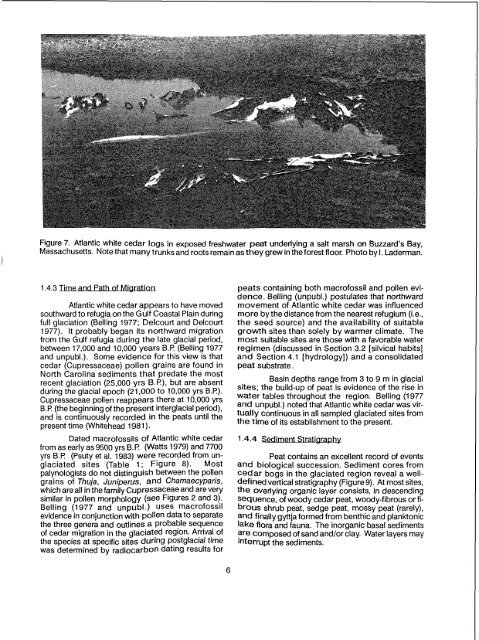The ecology of Atlantic white cedar wetlands - USGS National ...
The ecology of Atlantic white cedar wetlands - USGS National ...
The ecology of Atlantic white cedar wetlands - USGS National ...
Create successful ePaper yourself
Turn your PDF publications into a flip-book with our unique Google optimized e-Paper software.
Figure 7. <strong>Atlantic</strong> <strong>white</strong> <strong>cedar</strong> logs in exposed freshwater peat underlying a salt marsh on Buzzard's Bay,Massachusetts. Note that many trunks and roots remain as they grew in the forest floor. Photo by I. Laderman.<strong>Atlantic</strong> <strong>white</strong> <strong>cedar</strong> appears to have movedsouthward to refugia on the Gulf Coastal Plain duringfull glaciation (Belling 1977; Delcourt and Delcourt1977). It probably began its northward migrationfrom the Gulf refugia during the late glacial period,between 17,000 and 10,000 years B.P (Belling 1977and unpubl.). Some evidence for this view is that<strong>cedar</strong> (Cupressaceae) pollen grains are found inNorth Carolina sediments that predate the mostrecent glaciation (25,000 yrs B.P.), but are absentduring the glacial epoch (21,000 to 10,000 yrs B.P).Cupressaceae pollen reappears there at 10,000 yrsB.P (the beginning <strong>of</strong> the present interglacial period),and is continuously recorded in the peats until thepresent time (Whitehead 1981 ).Dated macr<strong>of</strong>ossils <strong>of</strong> <strong>Atlantic</strong> <strong>white</strong> <strong>cedar</strong>from as early as 9500 yrs B.l? (Watts 1979) and 7700yrs B.P. (Psuty et al. I 983) were recorded from unglaciatedsites (Table 1; Figure 8). Mostpalynologists do not distinguish between the pollengrains <strong>of</strong> Thuja, Juniperus, and Chamaecyparis,which are all in the family Cupressaceae and are verysimilar in pollen morphology (see Figures 2 and 3).Belling (1977 and unpubl.) uses macr<strong>of</strong>ossilevidence in conjunction with pollen data to separatethe three genera and outlines a probable sequence<strong>of</strong> <strong>cedar</strong> migration in the glaciated region. Arrival <strong>of</strong>the species at specific sites during postglacial timewas determined by radiocarbon dating results forpeats containing both macr<strong>of</strong>ossil and pollen evidence.Belling (unpubl.) postulates that northwardmovement <strong>of</strong> <strong>Atlantic</strong> <strong>white</strong> <strong>cedar</strong> was influencedmore by the distance from the nearest refugium (i.e.,the seed source) and the availability <strong>of</strong> suitablegrowth sites than solely by warmer climate. <strong>The</strong>most suitable sites are those with a favorable waterregimen (discussed in Section 3.2 [silvical habits]and Section 4.1 [hydrology]) and a consolidatedpeat substrate.Basin depths range from 3 to 9 m in glacialsites; the build-up <strong>of</strong> peat is evidence <strong>of</strong> the rise inwater tables throughout the region. Belling (1977and unpubl.) noted that <strong>Atlantic</strong> <strong>white</strong> <strong>cedar</strong> was virtuallycontinuous in all sampled glaciated sites fromthe time <strong>of</strong> its establishment to the present.Peat contains an excellent record <strong>of</strong> eventsand biological succession. Sediment cores from<strong>cedar</strong> bogs in the glaciated region reveal a welldefinedvertical stratigraphy (Figure 9). At most sites,the overlying organic layer consists, in descendingSequence, <strong>of</strong> woody <strong>cedar</strong> peat, woody-fibrous or fibrousshrub peat, sedge peat, mossy peat (rarely),and finally gyttja formed from benthic and planktoniclake flora and fauna. <strong>The</strong> inorganic basal sedimentsare composed <strong>of</strong> sand and/or clay. Water layers mayinterrupt the sediments.

















